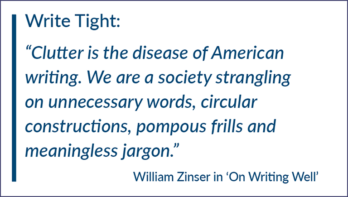I’ve always loved “the little book.” That’s what its original author, Will Strunk, called his writing guide which eventually became The Elements of Style. New Yorker editor and master stylist E.B. White, once a student under Professor Strunk at Cornell University, picked up the book, updated it, and Macmillan published it in 1959.
I was a brand new editor that year, and I learned the craft with a copy of Strunk and White, as it’s often called, at my elbow. (Charles Osgood wrote that he carries a copy in his pocket, although I can’t imagine why.) Now, 40 years later, a new publisher has released the fourth edition with revisions that will irritate the more traditional editors among us. But it’s still the same, wonderful, not exactly indispensable, but very helpful, “little book.”
Frankly, I believe the book has less value for the rules than it does as an example of effortless prose. Good prose should go down easily and not call attention to itself. Writing is a vehicle to tell stories and convey ideas. It should slide by easily, smoothly, gracefully. Good writing takes a good ear. It has a kind of rhythm and pace that aid the communication. If the reader stops to take notice of the prose, it distracts from the message you’re trying to get across. This is my definition of good style, and White in particular was a master of it.
Still, it is a book of rules, not a complete guide, but rules nevertheless. Strunk and, in turn, White, chose those rules of usage, principles of composition, matters of form, and words and expressions they believed were the most commonly violated or misused. And they were what is called, “prescriptive.” That is, they believed in right and wrong, a rule is a rule is a rule. They had no truck with the “descriptionists,” those relativists who bowed to modern education and usage. When Macmillan editors got jittery about White’s conservatism, he wrote to them: “I was saddened by your letter–the flagging spirit, the moistened finger in the wind, the examination of entrails, and the fear of little men. I don’t know whether Macmillan is running scared or not, but I do know that this book is the work of a dead precisionist and a half-dead disciple of his, and has got to stay that way.”
Not that White refused to recognize that language changes. He simply wanted to make sure the changes improved the clarity of writing and did not obscure it.
Which brings us to the change which will irritate what one reviewer called, “the mossbacks,” but which most editors accept as a good idea or a fait accompli: The male pronoun which refers to both men and women has been eliminated, banned, excised, cast out. The subject has been neutered.
I won’t weep nor protest the change. I’m just sorry that trends have dictated such a silly custom. In most cases of de-gendering, I believe, the language loses some directness, some vigor, some specificity (which is a virtue in writing). Nor will I offend those (him and her) who are sensitive to the use of the male pronoun to refer to both male and female.
Meanwhile, if the little book isn’t among your favorite reference tools, get a copy of the new edition. You’ll be a better editor for it.
— by Ron Wilson
Wilson is the former Executive Director of EPA.





